Strategic Marketing Science Question 2022
VerifiedAdded on 2022/10/17
|7
|1661
|13
AI Summary
Contribute Materials
Your contribution can guide someone’s learning journey. Share your
documents today.

1
Strategic Marketing Science
Name:
Institution:
Strategic Marketing Science
Name:
Institution:
Secure Best Marks with AI Grader
Need help grading? Try our AI Grader for instant feedback on your assignments.
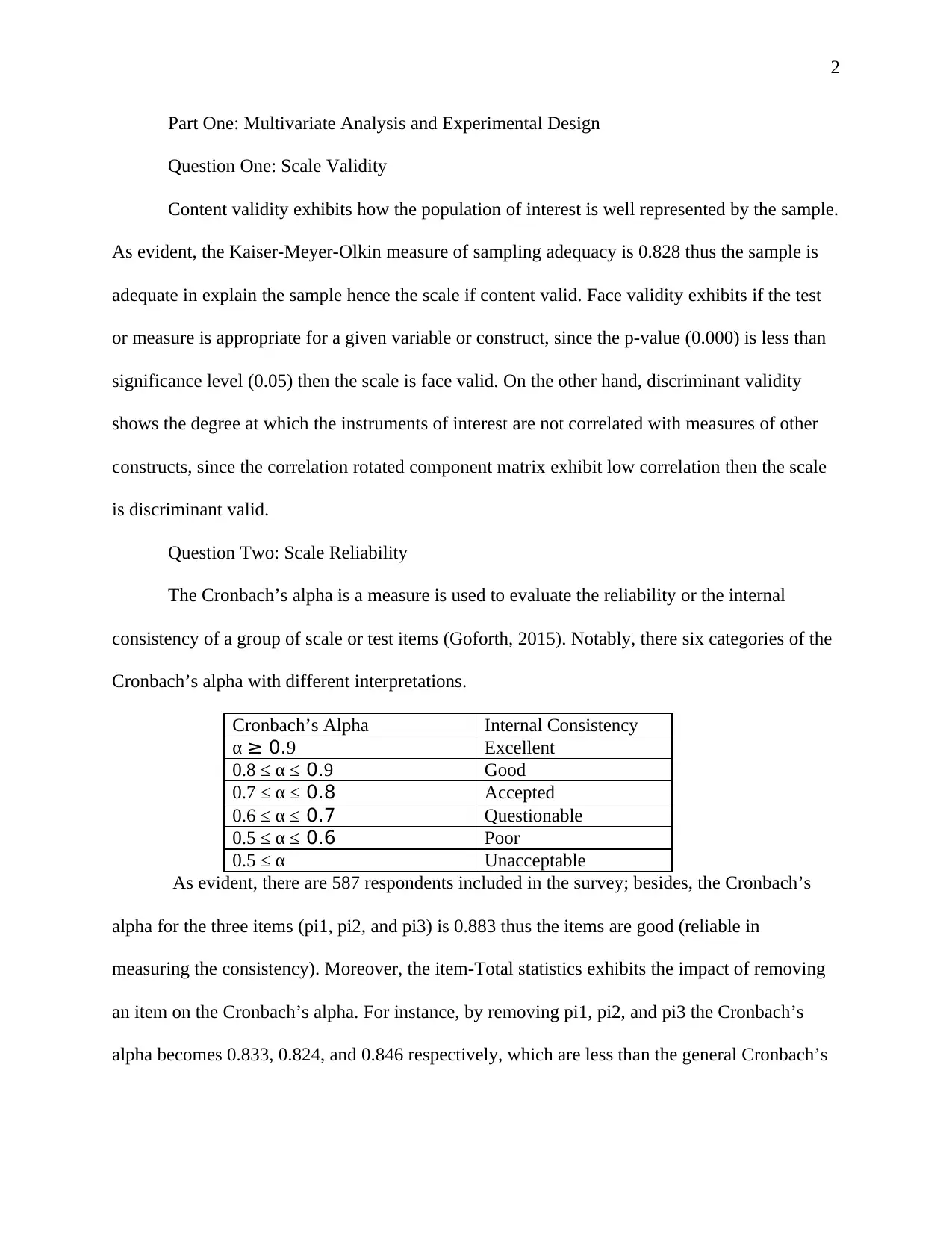
2
Part One: Multivariate Analysis and Experimental Design
Question One: Scale Validity
Content validity exhibits how the population of interest is well represented by the sample.
As evident, the Kaiser-Meyer-Olkin measure of sampling adequacy is 0.828 thus the sample is
adequate in explain the sample hence the scale if content valid. Face validity exhibits if the test
or measure is appropriate for a given variable or construct, since the p-value (0.000) is less than
significance level (0.05) then the scale is face valid. On the other hand, discriminant validity
shows the degree at which the instruments of interest are not correlated with measures of other
constructs, since the correlation rotated component matrix exhibit low correlation then the scale
is discriminant valid.
Question Two: Scale Reliability
The Cronbach’s alpha is a measure is used to evaluate the reliability or the internal
consistency of a group of scale or test items (Goforth, 2015). Notably, there six categories of the
Cronbach’s alpha with different interpretations.
Cronbach’s Alpha Internal Consistency
α ≥ 0.9 Excellent
0.8 ≤ α ≤ 0.9 Good
0.7 ≤ α ≤ 0.8 Accepted
0.6 ≤ α ≤ 0.7 Questionable
0.5 ≤ α ≤ 0.6 Poor
0.5 ≤ α Unacceptable
As evident, there are 587 respondents included in the survey; besides, the Cronbach’s
alpha for the three items (pi1, pi2, and pi3) is 0.883 thus the items are good (reliable in
measuring the consistency). Moreover, the item-Total statistics exhibits the impact of removing
an item on the Cronbach’s alpha. For instance, by removing pi1, pi2, and pi3 the Cronbach’s
alpha becomes 0.833, 0.824, and 0.846 respectively, which are less than the general Cronbach’s
Part One: Multivariate Analysis and Experimental Design
Question One: Scale Validity
Content validity exhibits how the population of interest is well represented by the sample.
As evident, the Kaiser-Meyer-Olkin measure of sampling adequacy is 0.828 thus the sample is
adequate in explain the sample hence the scale if content valid. Face validity exhibits if the test
or measure is appropriate for a given variable or construct, since the p-value (0.000) is less than
significance level (0.05) then the scale is face valid. On the other hand, discriminant validity
shows the degree at which the instruments of interest are not correlated with measures of other
constructs, since the correlation rotated component matrix exhibit low correlation then the scale
is discriminant valid.
Question Two: Scale Reliability
The Cronbach’s alpha is a measure is used to evaluate the reliability or the internal
consistency of a group of scale or test items (Goforth, 2015). Notably, there six categories of the
Cronbach’s alpha with different interpretations.
Cronbach’s Alpha Internal Consistency
α ≥ 0.9 Excellent
0.8 ≤ α ≤ 0.9 Good
0.7 ≤ α ≤ 0.8 Accepted
0.6 ≤ α ≤ 0.7 Questionable
0.5 ≤ α ≤ 0.6 Poor
0.5 ≤ α Unacceptable
As evident, there are 587 respondents included in the survey; besides, the Cronbach’s
alpha for the three items (pi1, pi2, and pi3) is 0.883 thus the items are good (reliable in
measuring the consistency). Moreover, the item-Total statistics exhibits the impact of removing
an item on the Cronbach’s alpha. For instance, by removing pi1, pi2, and pi3 the Cronbach’s
alpha becomes 0.833, 0.824, and 0.846 respectively, which are less than the general Cronbach’s
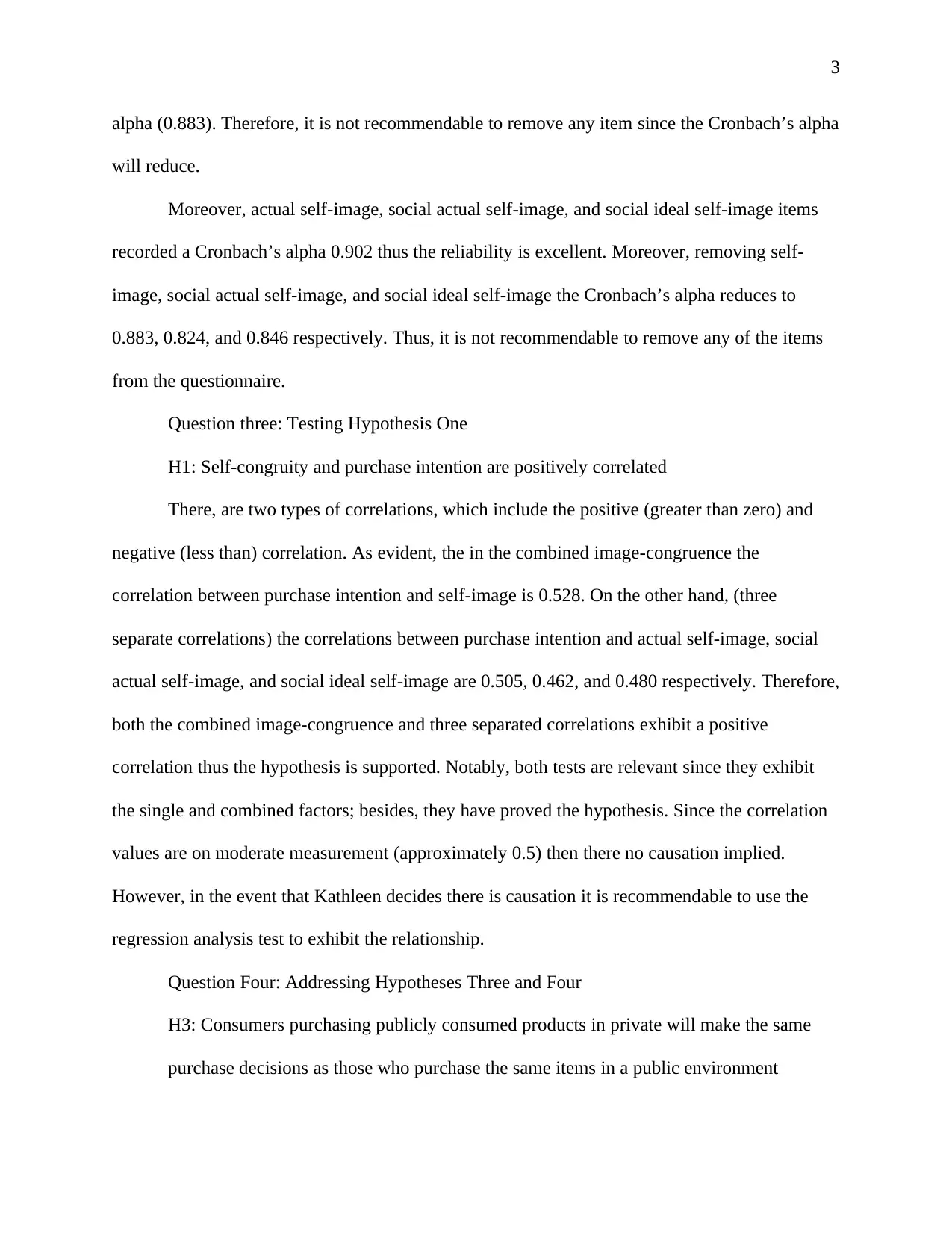
3
alpha (0.883). Therefore, it is not recommendable to remove any item since the Cronbach’s alpha
will reduce.
Moreover, actual self-image, social actual self-image, and social ideal self-image items
recorded a Cronbach’s alpha 0.902 thus the reliability is excellent. Moreover, removing self-
image, social actual self-image, and social ideal self-image the Cronbach’s alpha reduces to
0.883, 0.824, and 0.846 respectively. Thus, it is not recommendable to remove any of the items
from the questionnaire.
Question three: Testing Hypothesis One
H1: Self-congruity and purchase intention are positively correlated
There, are two types of correlations, which include the positive (greater than zero) and
negative (less than) correlation. As evident, the in the combined image-congruence the
correlation between purchase intention and self-image is 0.528. On the other hand, (three
separate correlations) the correlations between purchase intention and actual self-image, social
actual self-image, and social ideal self-image are 0.505, 0.462, and 0.480 respectively. Therefore,
both the combined image-congruence and three separated correlations exhibit a positive
correlation thus the hypothesis is supported. Notably, both tests are relevant since they exhibit
the single and combined factors; besides, they have proved the hypothesis. Since the correlation
values are on moderate measurement (approximately 0.5) then there no causation implied.
However, in the event that Kathleen decides there is causation it is recommendable to use the
regression analysis test to exhibit the relationship.
Question Four: Addressing Hypotheses Three and Four
H3: Consumers purchasing publicly consumed products in private will make the same
purchase decisions as those who purchase the same items in a public environment
alpha (0.883). Therefore, it is not recommendable to remove any item since the Cronbach’s alpha
will reduce.
Moreover, actual self-image, social actual self-image, and social ideal self-image items
recorded a Cronbach’s alpha 0.902 thus the reliability is excellent. Moreover, removing self-
image, social actual self-image, and social ideal self-image the Cronbach’s alpha reduces to
0.883, 0.824, and 0.846 respectively. Thus, it is not recommendable to remove any of the items
from the questionnaire.
Question three: Testing Hypothesis One
H1: Self-congruity and purchase intention are positively correlated
There, are two types of correlations, which include the positive (greater than zero) and
negative (less than) correlation. As evident, the in the combined image-congruence the
correlation between purchase intention and self-image is 0.528. On the other hand, (three
separate correlations) the correlations between purchase intention and actual self-image, social
actual self-image, and social ideal self-image are 0.505, 0.462, and 0.480 respectively. Therefore,
both the combined image-congruence and three separated correlations exhibit a positive
correlation thus the hypothesis is supported. Notably, both tests are relevant since they exhibit
the single and combined factors; besides, they have proved the hypothesis. Since the correlation
values are on moderate measurement (approximately 0.5) then there no causation implied.
However, in the event that Kathleen decides there is causation it is recommendable to use the
regression analysis test to exhibit the relationship.
Question Four: Addressing Hypotheses Three and Four
H3: Consumers purchasing publicly consumed products in private will make the same
purchase decisions as those who purchase the same items in a public environment
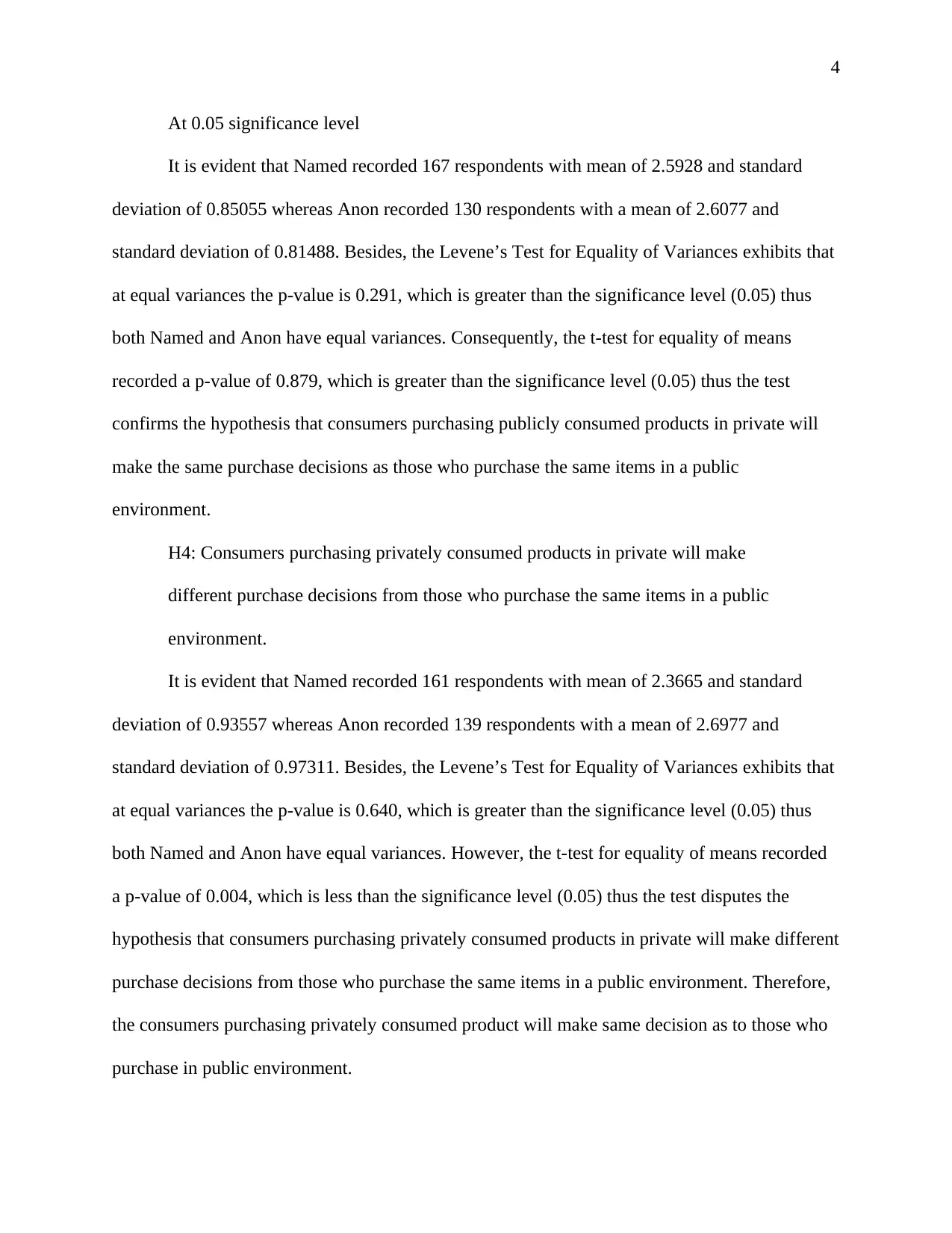
4
At 0.05 significance level
It is evident that Named recorded 167 respondents with mean of 2.5928 and standard
deviation of 0.85055 whereas Anon recorded 130 respondents with a mean of 2.6077 and
standard deviation of 0.81488. Besides, the Levene’s Test for Equality of Variances exhibits that
at equal variances the p-value is 0.291, which is greater than the significance level (0.05) thus
both Named and Anon have equal variances. Consequently, the t-test for equality of means
recorded a p-value of 0.879, which is greater than the significance level (0.05) thus the test
confirms the hypothesis that consumers purchasing publicly consumed products in private will
make the same purchase decisions as those who purchase the same items in a public
environment.
H4: Consumers purchasing privately consumed products in private will make
different purchase decisions from those who purchase the same items in a public
environment.
It is evident that Named recorded 161 respondents with mean of 2.3665 and standard
deviation of 0.93557 whereas Anon recorded 139 respondents with a mean of 2.6977 and
standard deviation of 0.97311. Besides, the Levene’s Test for Equality of Variances exhibits that
at equal variances the p-value is 0.640, which is greater than the significance level (0.05) thus
both Named and Anon have equal variances. However, the t-test for equality of means recorded
a p-value of 0.004, which is less than the significance level (0.05) thus the test disputes the
hypothesis that consumers purchasing privately consumed products in private will make different
purchase decisions from those who purchase the same items in a public environment. Therefore,
the consumers purchasing privately consumed product will make same decision as to those who
purchase in public environment.
At 0.05 significance level
It is evident that Named recorded 167 respondents with mean of 2.5928 and standard
deviation of 0.85055 whereas Anon recorded 130 respondents with a mean of 2.6077 and
standard deviation of 0.81488. Besides, the Levene’s Test for Equality of Variances exhibits that
at equal variances the p-value is 0.291, which is greater than the significance level (0.05) thus
both Named and Anon have equal variances. Consequently, the t-test for equality of means
recorded a p-value of 0.879, which is greater than the significance level (0.05) thus the test
confirms the hypothesis that consumers purchasing publicly consumed products in private will
make the same purchase decisions as those who purchase the same items in a public
environment.
H4: Consumers purchasing privately consumed products in private will make
different purchase decisions from those who purchase the same items in a public
environment.
It is evident that Named recorded 161 respondents with mean of 2.3665 and standard
deviation of 0.93557 whereas Anon recorded 139 respondents with a mean of 2.6977 and
standard deviation of 0.97311. Besides, the Levene’s Test for Equality of Variances exhibits that
at equal variances the p-value is 0.640, which is greater than the significance level (0.05) thus
both Named and Anon have equal variances. However, the t-test for equality of means recorded
a p-value of 0.004, which is less than the significance level (0.05) thus the test disputes the
hypothesis that consumers purchasing privately consumed products in private will make different
purchase decisions from those who purchase the same items in a public environment. Therefore,
the consumers purchasing privately consumed product will make same decision as to those who
purchase in public environment.
Secure Best Marks with AI Grader
Need help grading? Try our AI Grader for instant feedback on your assignments.
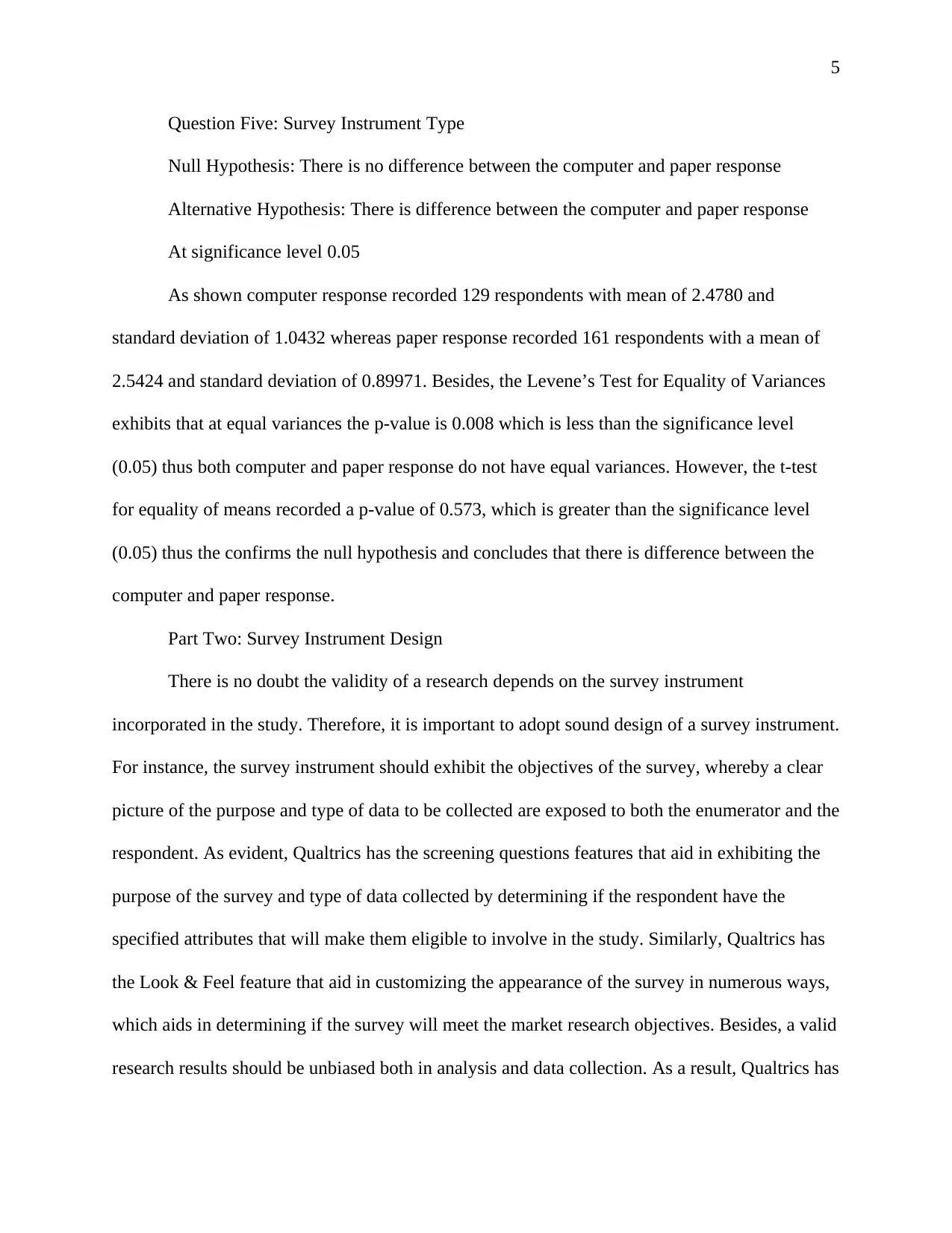
5
Question Five: Survey Instrument Type
Null Hypothesis: There is no difference between the computer and paper response
Alternative Hypothesis: There is difference between the computer and paper response
At significance level 0.05
As shown computer response recorded 129 respondents with mean of 2.4780 and
standard deviation of 1.0432 whereas paper response recorded 161 respondents with a mean of
2.5424 and standard deviation of 0.89971. Besides, the Levene’s Test for Equality of Variances
exhibits that at equal variances the p-value is 0.008 which is less than the significance level
(0.05) thus both computer and paper response do not have equal variances. However, the t-test
for equality of means recorded a p-value of 0.573, which is greater than the significance level
(0.05) thus the confirms the null hypothesis and concludes that there is difference between the
computer and paper response.
Part Two: Survey Instrument Design
There is no doubt the validity of a research depends on the survey instrument
incorporated in the study. Therefore, it is important to adopt sound design of a survey instrument.
For instance, the survey instrument should exhibit the objectives of the survey, whereby a clear
picture of the purpose and type of data to be collected are exposed to both the enumerator and the
respondent. As evident, Qualtrics has the screening questions features that aid in exhibiting the
purpose of the survey and type of data collected by determining if the respondent have the
specified attributes that will make them eligible to involve in the study. Similarly, Qualtrics has
the Look & Feel feature that aid in customizing the appearance of the survey in numerous ways,
which aids in determining if the survey will meet the market research objectives. Besides, a valid
research results should be unbiased both in analysis and data collection. As a result, Qualtrics has
Question Five: Survey Instrument Type
Null Hypothesis: There is no difference between the computer and paper response
Alternative Hypothesis: There is difference between the computer and paper response
At significance level 0.05
As shown computer response recorded 129 respondents with mean of 2.4780 and
standard deviation of 1.0432 whereas paper response recorded 161 respondents with a mean of
2.5424 and standard deviation of 0.89971. Besides, the Levene’s Test for Equality of Variances
exhibits that at equal variances the p-value is 0.008 which is less than the significance level
(0.05) thus both computer and paper response do not have equal variances. However, the t-test
for equality of means recorded a p-value of 0.573, which is greater than the significance level
(0.05) thus the confirms the null hypothesis and concludes that there is difference between the
computer and paper response.
Part Two: Survey Instrument Design
There is no doubt the validity of a research depends on the survey instrument
incorporated in the study. Therefore, it is important to adopt sound design of a survey instrument.
For instance, the survey instrument should exhibit the objectives of the survey, whereby a clear
picture of the purpose and type of data to be collected are exposed to both the enumerator and the
respondent. As evident, Qualtrics has the screening questions features that aid in exhibiting the
purpose of the survey and type of data collected by determining if the respondent have the
specified attributes that will make them eligible to involve in the study. Similarly, Qualtrics has
the Look & Feel feature that aid in customizing the appearance of the survey in numerous ways,
which aids in determining if the survey will meet the market research objectives. Besides, a valid
research results should be unbiased both in analysis and data collection. As a result, Qualtrics has
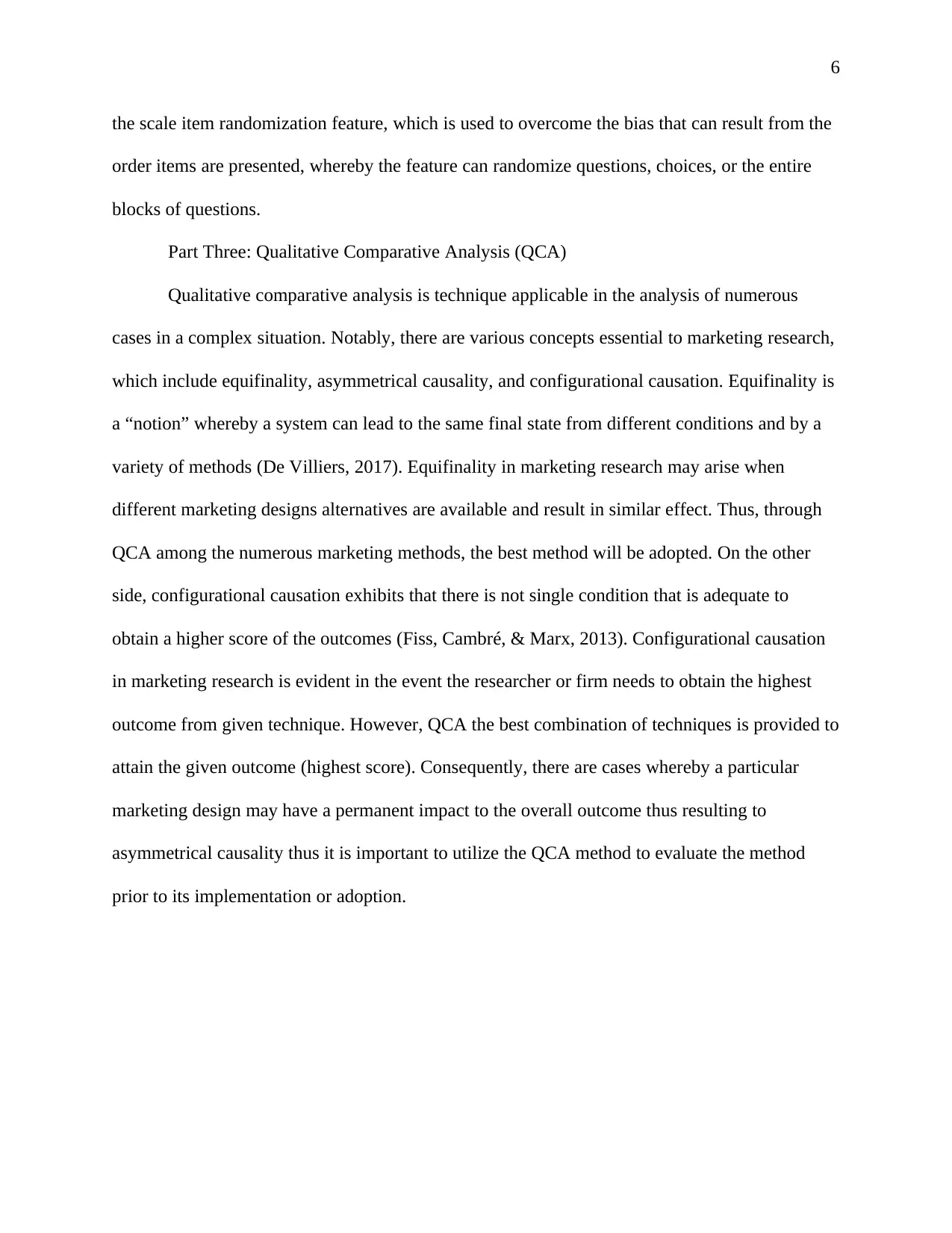
6
the scale item randomization feature, which is used to overcome the bias that can result from the
order items are presented, whereby the feature can randomize questions, choices, or the entire
blocks of questions.
Part Three: Qualitative Comparative Analysis (QCA)
Qualitative comparative analysis is technique applicable in the analysis of numerous
cases in a complex situation. Notably, there are various concepts essential to marketing research,
which include equifinality, asymmetrical causality, and configurational causation. Equifinality is
a “notion” whereby a system can lead to the same final state from different conditions and by a
variety of methods (De Villiers, 2017). Equifinality in marketing research may arise when
different marketing designs alternatives are available and result in similar effect. Thus, through
QCA among the numerous marketing methods, the best method will be adopted. On the other
side, configurational causation exhibits that there is not single condition that is adequate to
obtain a higher score of the outcomes (Fiss, Cambré, & Marx, 2013). Configurational causation
in marketing research is evident in the event the researcher or firm needs to obtain the highest
outcome from given technique. However, QCA the best combination of techniques is provided to
attain the given outcome (highest score). Consequently, there are cases whereby a particular
marketing design may have a permanent impact to the overall outcome thus resulting to
asymmetrical causality thus it is important to utilize the QCA method to evaluate the method
prior to its implementation or adoption.
the scale item randomization feature, which is used to overcome the bias that can result from the
order items are presented, whereby the feature can randomize questions, choices, or the entire
blocks of questions.
Part Three: Qualitative Comparative Analysis (QCA)
Qualitative comparative analysis is technique applicable in the analysis of numerous
cases in a complex situation. Notably, there are various concepts essential to marketing research,
which include equifinality, asymmetrical causality, and configurational causation. Equifinality is
a “notion” whereby a system can lead to the same final state from different conditions and by a
variety of methods (De Villiers, 2017). Equifinality in marketing research may arise when
different marketing designs alternatives are available and result in similar effect. Thus, through
QCA among the numerous marketing methods, the best method will be adopted. On the other
side, configurational causation exhibits that there is not single condition that is adequate to
obtain a higher score of the outcomes (Fiss, Cambré, & Marx, 2013). Configurational causation
in marketing research is evident in the event the researcher or firm needs to obtain the highest
outcome from given technique. However, QCA the best combination of techniques is provided to
attain the given outcome (highest score). Consequently, there are cases whereby a particular
marketing design may have a permanent impact to the overall outcome thus resulting to
asymmetrical causality thus it is important to utilize the QCA method to evaluate the method
prior to its implementation or adoption.
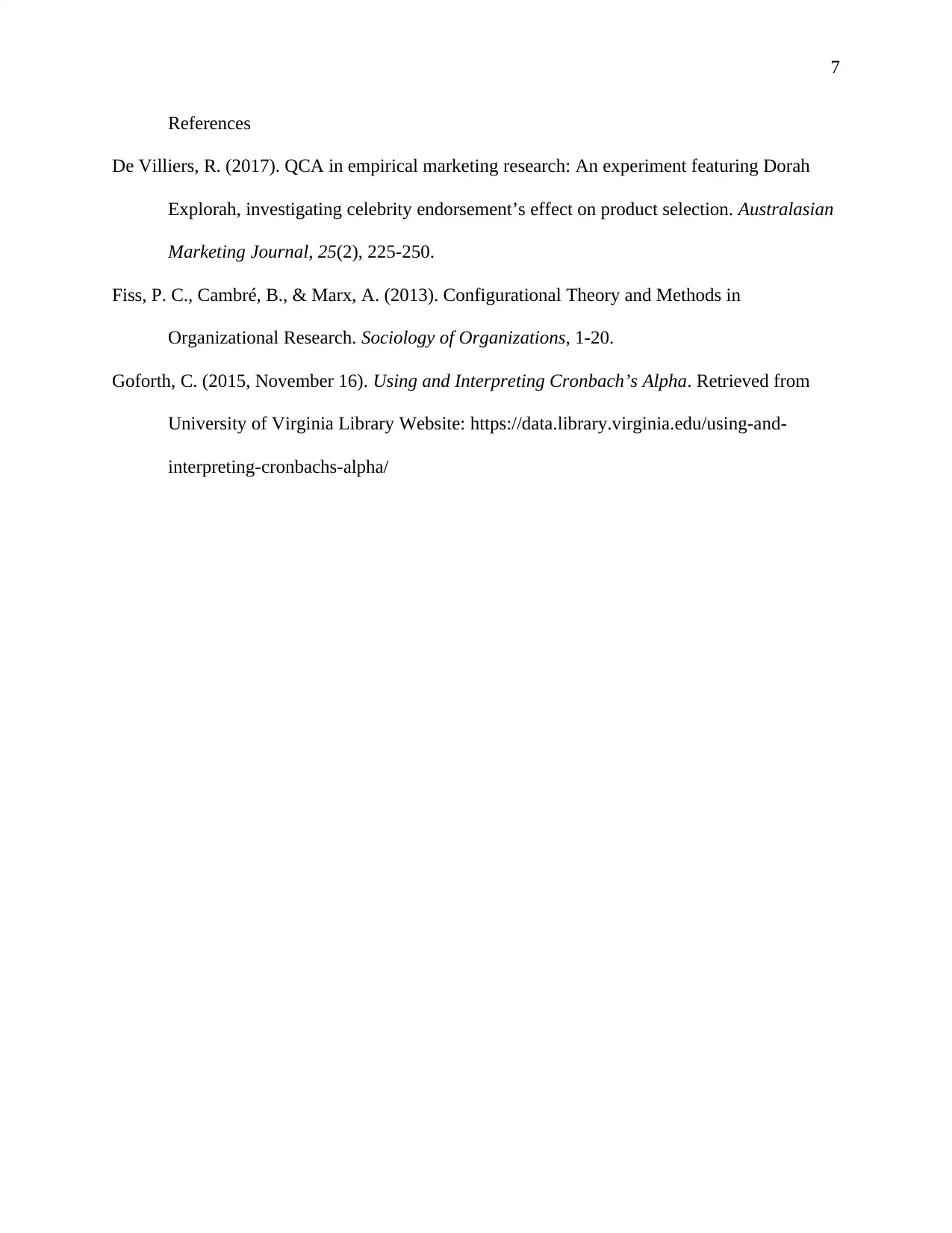
7
References
De Villiers, R. (2017). QCA in empirical marketing research: An experiment featuring Dorah
Explorah, investigating celebrity endorsement’s effect on product selection. Australasian
Marketing Journal, 25(2), 225-250.
Fiss, P. C., Cambré, B., & Marx, A. (2013). Configurational Theory and Methods in
Organizational Research. Sociology of Organizations, 1-20.
Goforth, C. (2015, November 16). Using and Interpreting Cronbach’s Alpha. Retrieved from
University of Virginia Library Website: https://data.library.virginia.edu/using-and-
interpreting-cronbachs-alpha/
References
De Villiers, R. (2017). QCA in empirical marketing research: An experiment featuring Dorah
Explorah, investigating celebrity endorsement’s effect on product selection. Australasian
Marketing Journal, 25(2), 225-250.
Fiss, P. C., Cambré, B., & Marx, A. (2013). Configurational Theory and Methods in
Organizational Research. Sociology of Organizations, 1-20.
Goforth, C. (2015, November 16). Using and Interpreting Cronbach’s Alpha. Retrieved from
University of Virginia Library Website: https://data.library.virginia.edu/using-and-
interpreting-cronbachs-alpha/
1 out of 7
Your All-in-One AI-Powered Toolkit for Academic Success.
+13062052269
info@desklib.com
Available 24*7 on WhatsApp / Email
![[object Object]](/_next/static/media/star-bottom.7253800d.svg)
Unlock your academic potential
© 2024 | Zucol Services PVT LTD | All rights reserved.


